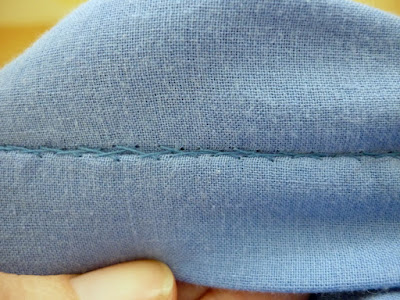Banded Collar Ruffle Front Blouse (Burda 04-2010-105)
Colour altered. It is difficult to photograph colours accurately indoors.
Hello friends, long time no blog! But it's not for lack of sewing here in the neighbourhood - it's for lack of photography. Ah well.
Last time I wrote, I was working on a muslin of this blouse. I liked the lines of the blouse and the way it felt when it was on, so I left off the ruffles and changed a bit of the construction. I made this top out of a wonderfully soft cotton batiste that I found in a remnant bin ages ago. Seriously, this fabric feels like a well-washed and worn favorite t-shirt. It is, however fairly sheer, so I decided to make it a double-layered shirt.
Here in Vancouver there are only a couple of weeks out of every summer where sleeveless tops are absolutely necessary, and only a couple of days where you might want your clothes to be as non-existent as possible, so doubling the fabric is a practical choice. As a bonus, it solved a few construction issues as well.
I constructed this garment (almost entirely) on my Singer 99K. I was glad of the tiny hole in the plate which meant my delicate fabric was less likely to get crammed into the bobbin chase. I even used the zipper foot from my Janome on the Singer to install the invisible zipper. Worked like a charm!
By choosing to make the front a double layer, I was able to omit the facing around the slit at the neck. This made everything so much simpler! I fused a piece of Pro-Sheer interfacing (that came in a sampler pack that I won on Pam's blog) to the inner layer straight down the middle of the slit before it was cut.* Then I stitched the neckline edge of both layers of batiste together. Once that was done, I reinforced the bottom of the slit with a drop of fray-check (a little extra insurance never hurts). When that was dry, I cut the center of the slit, pressed the neckline, then turned it and pressed again. Voila! A finished slit that won't flop around!
After that business, I proceeded to treat the two layers as one. I used the popular "burrito" method of attaching the back yoke. In this way, I could do that entire part by machine rather than by hand. I also used a French seam on the side seam without the zipper.
Here is a French seam (on the left side) and a bust dart.
I finished the armholes with bias made from the batiste scraps. I folded the bias in half and machine-stitched the raw edges of the armhole and the bias together, then pressed the bias to the inside and hand-stitched the folded edge in place, only catching the inner layers. (Another point where having two layers everywhere came in handy.)
Bias around the armhole.
I mentioned earlier that I was able to install the invisible zipper pretty well by using the zipper foot that came with my Janome (those plastic invisible zipper feet never work for me). I did switch over to my Janome to zigzag the raw seam allowances to the zipper tape. I just didn't have it in me to bind those edges with more bias.
Now for the embellishment. The neckline as drafted is far too low for my lifestyle. My idea to counter this without redrawing the neckline was to add a button and loop at the fullest point of my bust. I had planned on making a narrow tube of bias and inserting it into the neckline seam for the button loop, but I forgot in the excitement of figuring out how I was going to sew the neckline. I tossed around idea after idea and finally decided to sew two small covered buttons to the front of the blouse, supporting them on the inside of the shirt with two tiny shirt buttons (I think they are the size you might use for the collars of a button-down collar).
Two small covered buttons. I used two layers here, too, to avoid the button form shining through the fabric.
Then I took a small length of shirring elastic and threaded it through the holes of one of the shirt buttons (on the inside) and made a loop to go around the other shirt button. The elastic gives me a little stretch just in case and the loop allows me to open the shirt completely if I need to while dressing/undressing.
Pretty ingenious if I do say so myself!
And last of course was the hem. I am not usually one for making more work for myself, but I just couldn't bring myself to machine stitch the hem on a shirt that had no visible stitching from the outside. So I hand-stitched it, making use of the double layer again to hide my work. I noticed on this project just how much faster and more even my hand stitches are now compared to a few years ago. That's an encouraging thought!
This shirt is so comfortable! I can't wait for the weather to warm up! I have another version of this shirt cut out too - this one out of a silk-cotton print! Hooray!
*The front of this top is cut on the fold without cutting the slit. So before you sew the neckline, the front of the blouse just has a round neckline. Does that make sense?









Comments